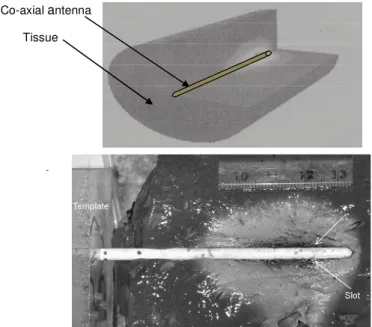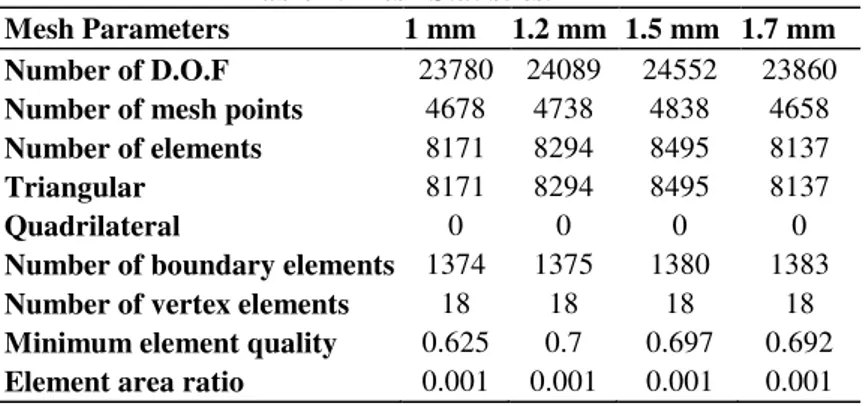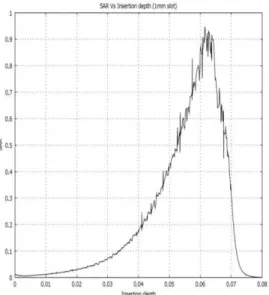FINITE ELEMENT ANALYSIS FOR OPTIMIZING ANTENNA
FOR MICROWAVE COAGULATION THERAPY
MAINI SURITA*, MARWAHA A., MARWAHA S.
Sant Longowal Institute of Engineering & Technology, Longowal (Deemed University) Distt. Sangrur, Punjab, India
*Corresponding Author: suritamaini@gmail.com
Abstract
Microwave coagulation therapy (MCT) is emerging as an attractive modality for thermal therapy of soft tissues targeted in short periods of time, making it particularly suitable for ablation of hepatic and other tumors. In this field of microwave coagulation therapy, the use of minimally invasive antenna is recognized as a very promising technique for the treatment of small tumors because a very thin antenna can be easily inserted inside the body and precisely localized using the advanced 3D imaging techniques and surgical robots. The authors investigated the microwave coaxial antenna operating at 2.45 GHz by varying the slots size for the removal of liver tumor. The analysis was done using 2D finite element modeling. By several optimization steps the antenna is simulated and optimized by comparing the values of specific absorption rate (SAR), mesh statistics and temperature distributions in tissue generated by the antenna with the variations of dimensions of slot from 1 mm to 1.7 mm.
Keywords: Antenna design, FEM model, Microwave coagulation therapy, Specific absorption rate, Microwave ablation, Coaxial antenna.
1. Introduction
Nomenclatures
B Magnetic field, T
c Specific heat capacity, J/kg.K D Electric flux density, C/m2 E Electric field strength, V/m H Magnetic field density J Temperature, K
k Thermal conductivity, W/m.K
Q absorbed electromagnetic energy, W/m3 Qm Metabolic heat generation, W/m3
Qp Heat loss due to micro-vascular blood perfusion, W/m 3
T Current density, A/m2
Greek Symbols
ρ
Mass density of the tissue, kg/m3ρ
free free charge density, C/m2
σ
Electrical conductivity, S/mAbbreviation
MCT Microwave coagulation therapy SAR Specific absorption rate, W/kg
by other physical properties. The dosimetric quantity that relates to heat generation in tissues is the Specific Absorption Rate (SAR), defined as:
ρ
σ
E2SAR= (1)
ρ
represents the mass density of the tissue andEis the rms value of the time harmonic electric field strength inside the exposed tissue. In this paper, SAR distributions for all cases were calculated and compared the results to determine the potential heating patterns of the antennas.To assist in antenna design for MWA, many researchers have employed the use of mathematical models rooted in computational electromagnetics (CEM). Computer modeling techniques for the simulation of hyperthermia treatment are invaluable tool. The complex geometries and tissue properties involved in simulation of MCT, especially perfusion term, makes computer simulations an ideal choice over analytical solutions which require many simplifying assumptions. The present work is based on electromagnetic (EM) numerical analysis approach of finite element method, because FEM uses piecewise approximation to solve the governing bioheat transfer equation. Geometric irregularities and regional heterogeneity are more easily handled by finite element method. FEM models can provide users with quick, accurate solutions to multiple systems of differential equations and as such, are well suited to heat transfer problems like ablation.
accurate prediction of the temperature profile in tissue is necessary. The temperature profile in tissue during an ablation procedure depends upon two physical phenomena: (1) interaction of microwaves with tissue and (2) heat transfer in tissue [6].
While considering the interaction of microwaves with tissue, propagation and absorption of microwaves in tissue is governed by Maxwell’s equations, stated in Eqs. (2)-(5).
free
D=ρ
⋅
∇ (2)
0 = ⋅
∇ B (3)
T B E ∂ ∂ − = × ∇ (4) T D J H ∂ ∂ + = × ∇ (5)
The electromagnetic fields radiations radiated in a given tissue by an appropriate antenna can be determined by solving the Maxwell’s equations, with the knowledge of tissue electromagnetic properties (permittivity and conductivity) and appropriate initial and boundary conditions, in order to develop accurate models of the ablation process.
For the heat transfer in the tissue, the temperature profile in tissue during ablation is obtained by solving a bioheat equation (6). The most widely used bioheat equation for modeling thermal therapy procedures is the Pennes bioheat equation [7].
m p Q Q Q T k dt dT
c =∇⋅ ∇ + − +
ρ (6)
The Pennes bioheat equation does not take in to account of heat loss due to blood flow through large, discrete vessels – “the heat sink effect.” The liver is a highly perfused organ having many large blood vessels. Ablations performed in proximity to these vessels are susceptible to the heat sink effect. The heat transfer due to blood flow in large vessels near tumors must be taken into account during planning of treatments with theoretical models.
2. Methods
2.1. Antenna design
A 2D finite element model (FEM) is developed to determine the absorbed power and the temperature distribution surrounding the single thin microwave coaxial antenna using COMSOL multiphysics [8].
6
m
m
1
2
0
-1
4
0
m
m
Microwave feeding point 2.45 GHz
Metallic coreφ0.5 mm
Dielectric sheet
φ(0.5 -1) mm
Metallic sheet Radiating slot 1.5 mm wide
PTFE catheter
φ(1 - 1.5) mm
φ(1.5 - 2) mm
Fig. 1. Microwave Coaxial Antenna Design.
2.2. Numerical analysis
Finite element method was employed for the numerical modeling and analysis of the antenna. The specific absorption rate (SAR) distribution produced by the microwave coaxial antenna has been rigorously investigated.
Figure 2 shows the antenna fed at 2.45 GHz, inserted in a volume of material with parameters as shown in Table 1. The antenna is placed axisymmetrically with liver tissue. The external surface of the liver tissue acts as boundary for the computational domain. In this problem, a low reflecting boundary condition is set on the surfaces, so that boundary does not disturb the EMF distribution. It is assumed that in the heat transfer problem the boundary is thermally isolated.
Tissue
Co-axialantenna
-The microwave source is set at the upper end of the coaxial cable. Taking advantage of the axial symmetry of the domain, a much more economical 2D FEM model is produced and intensively used in the preliminary study of the antenna design and in the primary estimates of the EMF parameters and temperature. Figures 3 and 4 show the temperature and surface distribution in the liver tissue with 2D modeling at the end of the heating process (the steady state), in a longitudinal plane. It is clear that the temperature field follows the heat source distribution quite well. Further the heat lesion is strong near the antenna, which leads to high temperatures, while far from the antenna, the heat lesion is weaker and the blood manages to keep the tissue at normal body temperature.
The finite element method (FEM) involves dividing a complex geometry into small elements for a system of partial differential equation, evaluated at nodes or edges. Figure 5 shows the axisymmeteric finite element mesh, with 1.5 mm slot, generated by FEMLAB using the free mesh parameters with the maximum element 0.003 mm. The mesh consists of 8495 triangular elements with 24552 degrees of freedom (D.O.F).
Table 1. Liver Parameters.
Name Values Expressions
K_liver 0.56 [W/(kg.K)] Thermal Conductivity, liver Rho_blood 1000[kg/m3) Density, blood
C_blood 3639 [J/(kg.K)] Specific heat, blood Omega_blood 3.6 e-3[1/s] Blood perfusion rate T_blood 37 [DegoC] Blood Temperature
P_in 10 [W] Input microwave power
Nu 2.45 [GHz] Microwave frequency
eps_diel 2.03 Relative permittivity, dielectric eps_cat 2.6 Relative permittivity, catheter eps_liver 43.03 Relative permittivity, liver sig_liver 1.69 [S/m] Electrical conductivity, liver
Fig. 5. Meshing for 1.5 mm Slot.
3. Results and Discussion
From the temperature distribution patterns it has been analyzed that a well defined focusing point of the EM fields is evidenced near the sensing tip of the wired sensor that could be responsible of a hot spot in the temperature distribution inside the tissue. Heating power deposited in the liver tissue is computed for different designs with varying slot dimensions as shown in Figs. 6 to 9.
It has been observed that with 10 W input power the amount of power absorbed (SAR) is around 9.4 for the slot of 1 mm (Fig. 6), 9.5 for 1.2 mm slot (Fig. 7), 9.9 for 1.5 mm slot (Fig. 8), and 9.7 for 1.7 mm slot (Fig. 9). The numerical results show that with the slot of 1.5 mm, maximum power (approx. 99%) is absorbed in the liver tissue. The antenna has been shown to give good specific absorption rate (SAR) with the slot of 1.5 mm and is suitable for MCT with respect to the other slots such as 1, 1.2, 1.5, and 1.7 mm. Table 2 shows all the mesh statistics for all sizes of slots. From this table it has been observed that the antenna with slot 1.5 mm has large numbers of degree of freedoms, no. of mesh points, no. of elements, boundary elements and minimum element quality. This antenna is also able to produce large number of elements.
Table 2. Mesh Statistics.
Mesh Parameters 1 mm 1.2 mm 1.5 mm 1.7 mm
Number of D.O.F 23780 24089 24552 23860
Number of mesh points 4678 4738 4838 4658
Number of elements 8171 8294 8495 8137
Triangular 8171 8294 8495 8137
Quadrilateral 0 0 0 0
Number of boundary elements 1374 1375 1380 1383
Number of vertex elements 18 18 18 18
Fig. 6. SAR Distribution vs. Insertion at Depth 1 mm.
Fig. 8. SAR Distribution vs. Insertion at Depth 1.5 mm.
Fig. 9. SAR Distribution vs. Insertion at Depth 1.7 mm.
4. Conclusion
model is rigorously analyzed on the basis of mesh statistics, SAR patterns, and temperature distributions in tissue generated by the antenna with the variations of dimensions of slot. The particular geometry with 1.5 mm slot of the coaxial antenna is the result of an optimization process with regard to the efficiency of the energetic transmission from the antenna to the exposed tissue.
References
1. Sterzer, F. (2002). Microwave medical devices.IEEE Microwave Magazine, 3(1), 65-70.
2. Seegenschmiedt, M.H.; Fessenden, P.; and Vernon, C.C. (1995). Thermoradiotherapy and thermo-chemotherapy. Springer-Verlag, 1995. 3. Seki, T.; Wakabayashi, M.; Nakagawa, T.; Itoh, T.; Shiro, T.; Kunieda, K.;
Sato, M.; Uchiyama, S.; and Inoue, K. (1994). Ultrasonically guided percutaneous microwave coagulation therapy for small carcinoma. Cancer, 74(3), 817-825.
4. Ito, K.; Ueno, K.; Hyodo, M.; and Kassi H. (1989). Interstitial applicator composed of coaxial ring slots for microwave hyperthermia.Proceedings of International Symposium on Antennas and Propagation, 253-256.
5. Habash, R.W.Y.; and Alhafid, H.T. (2006). Key developments in therapeutic applications of RF/microwaves. International Journal of Scientific Research,16, 451-455.
6. Yang, D.; Converse, M.C.; Mahvi, D.M.; and Webster, J.G. (2007). Expanding the bioheat equation to include tissue internal water evaporation during heating, IEEE Transactions on Biomedical Engineering, 54(8), 1382-1388.
7. Haemmerich, D.; dos Santos, I.; Schutt, D.J.; Webster, J.G. and Mahvi, D.M. (2006). In vitro measurements of temperature-dependent specific heat of liver tissue.Medical Engineering and Physics, 28(2), 194-197.




